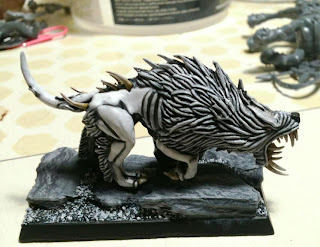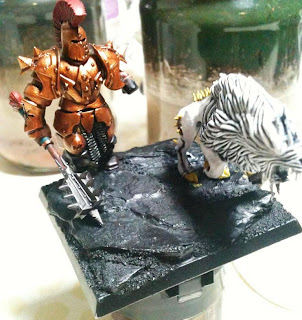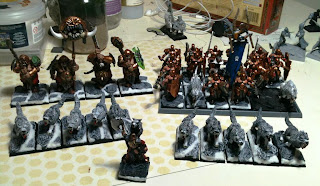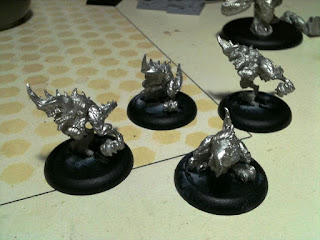So as it turns out, after my last fortnight’s mass-basing bonanza, I’ve pretty much run out of models that I can quickly base to gain some instant hobby progress. As a result, this fortnight has been a little more active in the fact that I actually had to put paint to model in order to maintain some semblance of hobby progress. For the most part I’ve been working on the final two unit fillers for my Chaos Warrior regiment which comprise of two wolves and my unit Champion. Between the two of these bases, they account for no less than 6 bodies in that regiment, which for my choice of formation counts for an entire rank. Understandably, this then gives completing these two models a sense of urgency when looking at the units’ progress as a whole. As can be seen in the pictures above and below, I’ve painted the wolves to resemble Tundra Wolves, a breed whose white coat provides them with a distinct advantage when hunting in the snowy plains and mountains. These contrast strongly with the Bronze and Flesh that features predominantly throughout the unit, hopefully drawing the eye to look closer at the army as a whole.
 |
| WIP Champion Filler Back |
As painters it is up to the individual to develop their own painting method that works for them, as everyone’s method is different. It may not be anything major that makes the style of two painters unique, but the differences are there and they must be acknowledged. To this end, I’m further exploring my own painting methods by using more natural bristled brushes. I’ve purchased additional GW brushes from my FLGS, keenly anticipating the different effects that may be achieved through using these brushes. The only downside I find is that GW’s price tag feels somewhat heavy-handed when you look at what you’re purchasing for your $8 - $14 AUD. But then again, you pay the price for quality don’t you?
On the Tournament front, I’ve been eagerly awaiting the release of the Players Pack for the Tricksters Blade event. From what I can wheedle out of the Tournament Organiser, the points limit for the tournament will be 2400, operating on a similar scale to the Ides of March Tournament held earlier this year in Brisbane. As a bonus though, many of the standard scenarios from the main Rulebook will be used, an improvement over the Pitched-Battle only present at Ides. Looking over my current army progress as seen below, I can confidently say that approximately half my army is assembled and painted depending on wargear choices, while the other half is either in the process of being built or is awaiting bits to arrive from various places in the US or the UK.
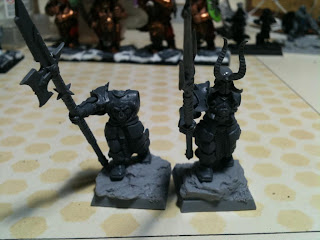 |
| WIP Chosen |
Number of Days until Trickster’s Blade: 43
Number of Units Completed: 5
Number of Points painted this fortnight: 96 (6 Warriors of Chaos)
See you all next time,
Trev

